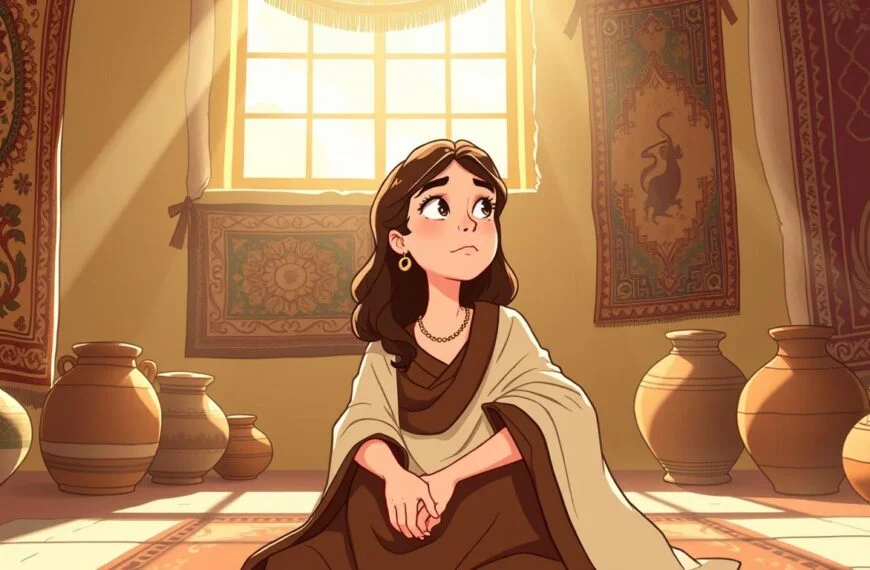Ever thought about how a simple flower like the lily holds deep meanings in the Bible? The phrase “Lily in the Bible” brings up a world of symbols. These symbols are found in both the Old and New Testaments.
The name “Lily” might not point to a single person. Yet, it stands for many things in the Bible. It often means purity, beauty, and God’s abundance. Learning about Lily helps us see more of the Bible’s symbols and the plants of ancient Palestine.
The Concept of Lily in Biblical Texts
Lilies in the Bible mean a lot. They show beauty and God’s care. The word “shoshannah” in Hebrew means many flowers, like “lily” in English. This shows how important these flowers were in old stories.
Experts think the flowers in the Bible might be things like asphodel, irises, and tulips. These plants are all in the Liliaceae family.
The New Testament talks about the scarlet martagon, or “red Turk’s-cap lily.” It shows God’s love for what He made. In Matthew 6:28-33, Jesus says to look at lilies. He shows how God takes care of us, just like He does with flowers.
In the Song of Solomon and other parts of the Bible, lilies mean a lot. They might be like anemones or pheasant’s eye. These stories help us see the beauty of nature and trust in God, even when things are hard.
Symbolism of the Lily in Scripture
The Lily in the Bible means a lot. It talks about purity, beauty, and God’s presence. Lilies show God’s care for the world. They make us think about life and nature.
In *Song of Solomon 2:1*, a woman calls herself “the lily of the valleys.” This shows her beauty and innocence. In *Song of Solomon 2:2*, a man says his love is like “a lily among thorns.” This means she stands out, even in tough times.
Lilies in the Bible mean more than just flowers. They talk about spiritual and moral lessons. The lily and the rose of Sharon are symbols full of meaning. They show the special role of flowers in scripture.
The *Song of Solomon* compares lovers to an apple tree and forest trees. This shows they are special and unique, like lilies. Reading these verses, we see the beauty of love and God’s creation.
Who Is Lily In The Bible?
The lily in the Bible is full of meaning. It is mentioned thirteen times in different parts of the Bible. It stands for purity, beauty, and God’s care.
In 1 Kings 7:19, the lily is part of Solomon’s temple design. This shows its importance in a place of holiness and beauty. It shows Lily’s role as a symbol of beauty and spiritual importance.
In the Song of Solomon, the lily means love. This adds to Lily’s role in love and faith. For example, Hosea 14:5 uses the lily to talk about Israel’s growth and renewal.
Jesus talks about lilies in Matthew 6:28-29 and Luke 12:27. He uses them to show God’s care for us. This makes Lily more than just a flower. It shows her importance in teaching us to trust and have faith.
Lilith: Myths vs. Biblical Text
The story of Lilith is filled with myths from Jewish folklore, not the Bible. She is often seen as Adam’s first wife. This section looks at how myths and stories have shaped our view of Lilith, showing a gap between what’s written and what’s told.
Origins of the Lilith Legend
The word “lilith” is rare in the Bible, found only in Isaiah 34:14. Scholars often translate this as “screech owl,” linking Lilith to darkness and fear. Her role as a danger has had a big impact on culture. But, the real start of the Lilith story comes from later tales, like the Alphabet of Ben Sirach.
In these stories, Lilith is Adam’s first wife, left behind. This contrasts her story with others in the Bible, giving her a unique place. It shows her as a powerful figure, unlike many women in old stories.
Misinterpretations of Scriptural References
Many stories about Lilith come from misreading the Bible. Isaiah 34 talks about “night creatures” or “night monster,” but these ideas are often taken too far. This has led to Lilith being seen as both a bad spirit and a symbol of female strength.
Looking closely at the Bible, we see how stories about Lilith grew. They reflect old debates about gender and power. These ideas still affect us today.
Understanding the Hebrew Term ‘Shushan’
The Hebrew term shushan means more than one flower. It shows many plants growing in ancient Palestine. We will look at the plants linked to shushan, like lilies and their role in biblical stories.
Different Plants Associated with the Term
Shushan includes flowers like lilies, tulips, and hyacinths. Each type of lily is important for understanding flowers in the Bible. The water-lily, used in decorations like Solomon’s Temple, is also part of shushan.
Historical Context of Lilies in Ancient Palestine
In ancient Palestine, lilies grew in the area’s farms. These flowers showed the beauty of the seasons and were important in daily life. The Bible talks about lilies in buildings and symbols, showing their big role in culture.
Knowing why some lily types disappeared helps us understand the Bible’s time. This knowledge shows how much these flowers meant then.
Key Biblical References to Lilies
Lilies are very important in the Bible. They are symbols in both the Old and New Testaments. We will look at key passages that show how special these flowers are. They are found in the Song of Solomon and in Jesus’ teachings.
Song of Solomon and its Floral Imagery
In the Song of Solomon, lilies are used to show beauty and uniqueness. The text talks about these flowers a lot. It uses them to express deep feelings and love.
The beloved is said to feed among the lilies. This creates a peaceful scene that shows love and calm. Lilies are described as elegant and divine. They were even used in the design of Solomon’s temple.
References in the New Testament
The New Testament talks about lilies too. Jesus uses them to teach about God’s care for us. In Luke 12:27-28, Jesus says lilies are more beautiful than Solomon’s glory.
This teaches us to trust in God and not worry about the world. The New Testament uses lilies to connect spiritual truths with scripture. This makes us think about our inner beauty and God’s care for us.

Cultural Significance of Lilies in Biblical Times
Lilies were very important in ancient cultures, especially in the Bible. They were loved for their beauty and deep symbolism. Jesus talked about lilies in the Sermon on the Mount. He used them to show God’s care for all living things.
In those days, lilies were more than just flowers. They were part of religious rituals and art. Leaders like Pastor Rick Warren say lilies remind us to trust God. They show us to have faith without worry.
The symbolism of lilies goes beyond their looks. They stand for hope, purity, and God’s care. By looking at lilies, people could see God’s presence in their lives. The apostle Peter said believers are like lilies, strong and lasting through hard times.
Lilies in the Song of Solomon
In the Song of Solomon, lilies show deep love and admiration. The beloved loves lilies for their purity. This shows how important relationships are in the story.
Lilies are mentioned a lot in the book. They show beauty and closeness between characters. This makes their longing and desire clear.
The Relationship Between the Beloved and the Lily
The beloved says, “As the lily among thorns, so is my love among the daughters.” This is a strong symbol of love’s beauty and purity. It shows a deep bond between the characters.
The lily stands for growth and beauty. It adds depth to the story’s themes. This makes us think deeply about its meaning.
Literary Analysis of Lily Imagery
Looking at how lilies are described in the Song of Solomon shows its beauty. Metaphors and similes make the story feel richer. Lilies are special because of their purity and innocence.
The story shows a deep connection between Christ and the Church. This makes lilies more than just flowers. They symbolize love and divine connection.
The song connects the beloved’s love with lilies. Literary devices make the story even more beautiful. Lilies in the Song of Solomon show love, purity, and divine connection.
For more on lilies in the Bible, check out this link.
The Role of Lilies in Jesus’ Teachings
In the Sermon on the Mount, Jesus talks about lilies. He shows how God takes care of us. He says we shouldn’t worry about things like food and clothes.
Jesus says even Solomon, who was very rich, didn’t look as good as lilies. This shows God’s care for all of us. It tells us to trust in God, not worry.

Jesus says if we focus on God, He will take care of us. This means we don’t have to worry about everyday things. Lilies remind us of God’s love and care for us.
Modern Interpretations and Misconceptions
The myth of Lilith has caught a lot of attention lately, especially among feminists. Today, Lilith is seen as a symbol of female power. This is a big change from how she was seen before.
People talk about Lilith in many ways. They see her as a symbol of fighting against old ideas that see women as less than men. Feminists see Lilith as a sign of freedom and being your own person.
Feminist Perspectives on Lilith and Lily Mythology
Since Johann Wolfgang von Goethe wrote about Lilith in 1808, she has become more famous. She has been in books, movies, music, and comics. This has made her a symbol of fighting for equality.
In 1972, Lilly Rivlin wrote an important article in Ms. magazine. She made Lilith seem like a hero who refused to be controlled. This idea was even more powerful when the magazine Lilith was started in 1976. It showed Lilith as a symbol of women fighting for equality with men.
Many women, both Jewish and not, are interested in Lilith. This is shown by events like Lilith Fair. It celebrates women in music and aims to inspire them. Even though old texts don’t talk much about Lilith, people have made her very important. They see her as a symbol of being free and in charge of your life.
Conclusion: The Lasting Impact of Lily in Biblical Lore
Lilies in the Bible show their lasting impact on faith and culture. They are symbols of beauty and God’s care. Looking at Bible passages about lilies helps us understand their deep meaning.
Lilies are mentioned in the Song of Solomon and Jesus’ teachings. They remind us to trust in God and have faith. They also connect us to nature and God’s watchful eye.
The story of lilies in the Bible invites us to think about beauty, resilience, and faith. By exploring these stories, we see lilies as symbols of hope. They remind us of God’s presence in our lives.
FAQ
What does the term "Lily" mean in biblical contexts?
In the Bible, “Lily” means beauty, purity, and lots of things. It shows God’s love for all living things.
How are lilies represented in biblical texts?
Lilies are in the Bible a lot. They show God’s beauty and care. The word “shushan” in Hebrew means many flowers, showing their importance in old times.
Are there specific scripture passages that mention lilies and their symbolism?
Yes, Matthew 6:28 and Luke 12:27 talk about lilies. They teach us about faith and trusting God. They show how nature reflects God’s love.
What is the identity of "Lily" as a figure in the Bible?
“Lily” is not a person in the Bible. But, lilies are used to talk about faith and God’s love in different ways.
What are the origins of the Lilith legend?
Lilith is not in the Bible, but people think she was Adam’s first wife. She is seen as a rebel, which has led to wrong ideas about her.
How have misinterpretations of scripture impacted the understanding of Lilith?
Many stories about Lilith come from wrong ideas about Isaiah 34:14. These mistakes have changed how people see her and the Bible.
What does the Hebrew term "shushan" signify?
“Shushan” in Hebrew means many flowers, like lilies, tulips, and hyacinths. It shows the variety of flowers in the Bible and their meanings.
How were lilies significant in ancient Palestine?
Lilies were important in ancient Palestine. They were part of farming and showed the beauty of the seasons. They were a big part of the culture and stories in the Bible.
What role do lilies play in the Song of Solomon?
In the Song of Solomon, lilies are used to talk about love and beauty. They add to the feelings in the poetry.
How does Jesus reference lilies in his teachings?
Jesus talks about lilies in his teachings. He uses them to teach about God’s care and the importance of faith.
What modern interpretations relate to the myth of Lilith?
Today, some women see Lilith as a symbol of power. This view is different from old ideas and is part of new talks about women in the Bible.

Rockin’ the faith, one verse at a time!
Growing up, the Bible’s stories deeply impacted me. Now, with over 15 years of preaching experience, I blend timeless teachings with modern technology, making them relevant for today’s world.
Bible Hub Verse is my platform to share historical insights and thought-provoking articles, exploring both familiar and uncommon Christian topics. My passion is building a welcoming online space for everyone to learn, grow in their faith, and discover the Bible’s enduring message.
Join the journey!
God bless you.







